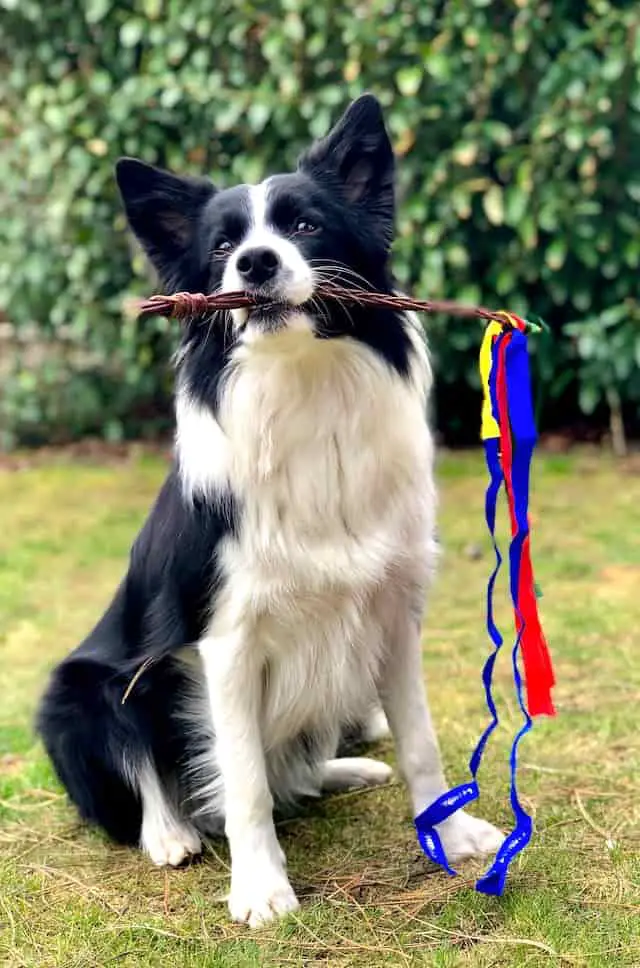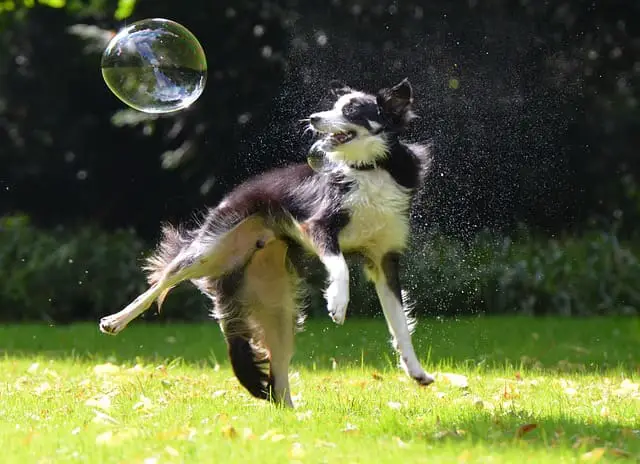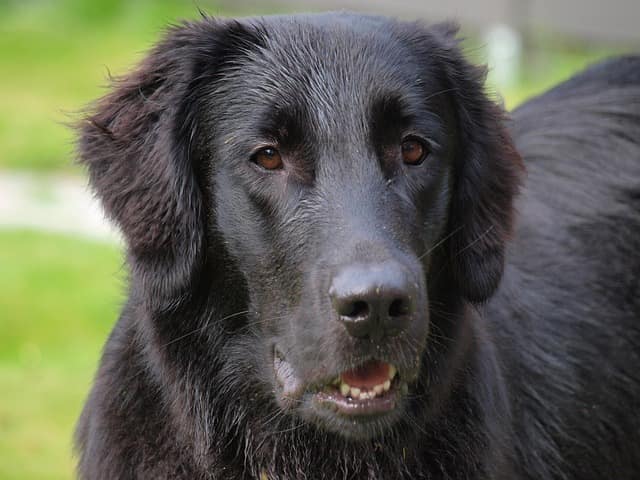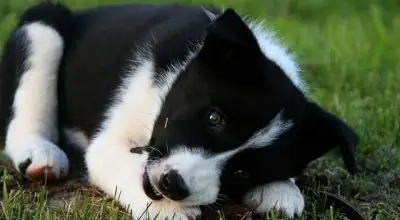In the world of dogs, few breeds possess the extraordinary combination of intelligence, athleticism, and companionship quite like the Border Collie and Flat-Coated Retriever. These remarkable breeds have captured the hearts of dog enthusiasts worldwide with their unique abilities and endearing personalities. However, it is essential for prospective owners to be aware of the health considerations associated with these breeds to ensure the well-being and longevity of their furry companions.
The Border Collie, renowned for its exceptional sheep herding skills, is not only an incredibly intelligent breed but also highly trainable and obedient. With their boundless energy and innate problem-solving talents, they excel in a variety of activities and tasks. From agility and obedience competitions to flyball and frisbee, Border Collies thrive on mental and physical challenges. To maintain their happiness and prevent behavioral issues, these dogs require ample stimulation, both in terms of exercise and mental engagement.
Meanwhile, the Flat-Coated Retriever, originally bred as a versatile game retriever on both land and water, continues to be a popular choice for various tasks today. These magnificent dogs possess a joyful and exuberant nature that makes them wonderful companions. Their enthusiasm for life is evident in their love for competitive sports such as agility, rally, and obedience. Furthermore, their gentle temperament and natural affinity for human interaction make them well-suited for therapy work, bringing comfort and joy to those in need.
Characteristics of a Border Collie and Flat-Coated Retriever
Border Collies are renowned as herding dog’s native to the Anglo-Scottish border region, as their name suggests. While their primary role is herding sheep, they are adaptable and can fulfill various responsibilities. With their exceptional intelligence and quick learning abilities, they excel in tasks requiring mental agility. However, due to their high energy levels and need for mental stimulation, they are best suited for families who can provide them with work or a sense of purpose.
On the other hand, for individuals or families leading active lifestyles, welcoming a flat-coated retriever into their lives is highly recommended. These sociable and incredibly active canines thrive in the companionship of their human counterparts, particularly those who engage in active and mobile routines.
They enthusiastically participate in sports like swimming, jogging, and other vigorous activities. True to their name, they excel at retrieving tasks, whether it be retrieving birds or unconventional items such as tennis balls.
| Characteristics | Border Collie | Flat-Coated Retriever |
|---|---|---|
| Height | 45cm – 55cm | Male – 58cm – 62cm Female – 55cm – 59cm |
| Weight | 12kg – 20kg | 27kg – 32kg |
| Lifespan | 10 – 17 years | 8-10 years |
| Suitable for | Active families with older children, those involved in canine sports | Active families who can provide ample exercise and mental stimulation |
| Temperament | Vigorous, energetic, loyal | Friendly, energetic, intelligent |
Breed History
The Border Collie has a rich history dating back to the 1700s, although it wasn’t officially named until 1915. These dogs were specifically bred for their exceptional working abilities and have been extensively utilized by shepherds in the Scotland-England border region for decades.
Breeders of Border Collies express concerns that an excessive focus on aesthetics and appearance may diminish the breed’s inherent character. Therefore, these breeders consistently emphasize and prioritize the breed’s working traits, resulting in observable distinctions between working strains and exhibition strains.
In contrast, retrieving breeds like the Flat-Coated Retriever were developed in the mid-19th century in response to the rising popularity of bird shooting as a recreational pursuit. These retriever breeds were created through crosses between spaniels, setters, and water dogs.
Notably, Water Spaniels, Collies, and St. John’s water dogs from Newfoundland played a significant role in the evolution of the Flat-Coated Retriever. The aim was to produce a dog capable of effectively retrieving birds after they were shot and had fallen to the ground.
Appearance Difference
The Border Collie, with its striking features and athletic build, exudes a sense of elegance and agility. One of their defining characteristics is their eyes. Typically, Border Collies have oval-shaped eyes that are dark in color, which adds to their keen and alert expression. However, in some cases, Border Collies with merle coats may possess mesmerizing blue eyes, further enhancing their striking appearance. These eyes reflect the intelligence and focus that are hallmarks of the breed.
Another notable feature of the Border Collie is its ears. These can be either erect or semi-erect, and they have a distinctive triangular shape. The position and shape of the ears contribute to the breed’s alert and attentive expression. Whether the ears are fully upright or have a slight fold, they add to the overall balance and aesthetics of the Border Collie’s face.
In contrast, the Flat-Coated Retriever possesses a different set of distinctive features that contribute to its unique appearance. The most notable attribute of the Flat-Coated Retriever is its lustrous, flat-lying coat. This coat comes in two classic colors: black or liver. The dense feathering on the legs and tail adds to the breed’s charm and elegance. The glossy and flowing coat accentuates the breed’s graceful movements and adds a touch of sophistication to its overall appearance.
The Flat-Coated Retriever’s head is another distinguishing feature. Compared to other retriever breeds, these dogs have a longer head. This elongated structure, combined with a well-defined stop, gives the breed an intelligent and friendly expression. The longer headsets the Flat-Coated Retriever apart and adds to its distinctive appearance, making it instantly recognizable.
Size Comparison
Border Collies, on average, have a weight range of 12 to 20 kilograms (26-44 lb). The actual weight can vary depending on factors such as genetics, diet, and exercise. In terms of height, Border Collies typically measure between 46 to 56 centimeters (18-22 inches). Males tend to be slightly larger than females in both height and weight, with males averaging a slightly higher height and weight compared to females.
On the other hand, the Flat-Coated Retriever, being a larger breed, has different size specifications. The shoulder height of a male Flat-Coated Retriever typically ranges from 23 to 24.5 inches, while females generally measure between 22 to 23.5 inches in height. When it comes to weight, Flat-Coated Retrievers are heavier than Border Collies, with an average range of 55 to 70 pounds. As with any breed, individual dogs may fall outside these averages based on various factors.
It’s important to note that these size and weight ranges are general guidelines. At the end of the day, proper nutrition, regular exercise, and veterinary care are essential in ensuring that dogs of both breeds maintain a healthy weight and overall well-being.
Coats & Colors
The Border Collie exhibits either a smooth or medium-length coat, and the most common color combination is black and white. However, other colors like brown, blue merle, red, and multicolored patterns are also frequently seen. This wide range of coat colors adds to the visual diversity of the breed.
On the other hand, the Flat-Coated Retriever possesses a straight, medium-length coat that offers protection against various environmental elements. While there is feathering present in specific areas of the body, it should not be excessively long.
In particular, males may develop a thicker and longer coat resembling a mane around the neck region. The coat of the Flat-Coated Retriever is available in solid liver, a rich reddish-brown shade, or solid black.
Personality & Temperament Difference of a Border Collie and Flat-Coated Retriever

Border Collies are renowned for their reliability, attentiveness, liveliness, and alertness. They form strong bonds with their owners and families. However, their innate tendency to herd anything that moves, including young children, means they may not be the best choice for households with very young kids. Without adequate time and exercise, children may become bored, leading to potential misbehavior as their active minds continuously seek stimulation.
In contrast, often referred to as the Peter Pan of dogs, the Flat-Coated Retriever possesses an eternal optimism and cheerful outlook on life. This amiable and intelligent breed is upbeat and highly adaptable. While their enthusiasm and mischievous behavior add to their charm, it’s important to meet their moderate exercise needs through regular physical activity. By providing the necessary exercise, they can maintain their friendly and composed personalities.
Dogs towards Family
Border Collies are widely recognized for their unwavering loyalty and strong bond with humans. They make excellent and devoted companions. Due to their high stamina and energy levels, providing them with ample exercise opportunities is crucial. To thrive, they require both mental and physical stimulation.
While they can be great family dogs, if left alone or lacking stimulation, they may develop destructive behaviors and behavioral issues. Similarly, with proper training and socialization, Flat-Coated Retrievers can be wonderful additions to a household.
Generally, they are affectionate and friendly towards children. However, it’s important to note that their high energy levels may be overwhelming for young toddlers. Therefore, it is necessary to closely monitor and manage their exuberance when around small children.
Kids
With proper socialization and training from a young age, Border Collies’ warm and affectionate temperament makes them excellent companions for children. However, caution should be exercised with younger children. Due to their strong herding instincts, they may attempt to herd children, which can unintentionally lead to knocking them down. Supervision and guidance are essential to establish a harmonious interaction and ensure safety.
Likewise, Flat-Coated Retrievers have a great rapport with energetic older children. Their lively nature allows them to engage in playful activities like running, swimming, and playing fetch for hours. However, their enthusiasm can be overpowering for toddlers, as their wagging tails may accidentally knock them down.
It is important to consider the dog’s size and activity level when interacting with small children to ensure everyone’s safety.
Other People
Border Collies are not typically known to be aggressive dogs, but they may exhibit protective behaviors if an unfamiliar person enters their home or approaches the front door. Their ability to bark and intimidate strangers can make them effective as guard dogs.
Alternatively, the size of the Flat-Coated Retriever may give people pause in the presence of strangers or intruders, but their inherent nature is more inclined towards friendliness rather than hostility. It is well-known that they are more likely to show affection and give kisses to strangers rather than barking at them when they meet.
Dogs & Other Animals
Border Collies often display friendliness towards larger dogs or dogs of similar size. However, due to their herding instincts, they may try to herd smaller dogs, which can make interactions challenging. Smaller dogs may not appreciate being herded and disagreements or fights can occur, even without inherent aggression. Smaller dogs may feel intimidated by Border Collies, especially when the larger dog displays behaviors like nipping and glaring at them.
Similarly, Flat-Coated Retrievers generally get along well with other dogs and can have positive relationships with cats, especially if they are raised together from a young age. However, it is important to consider their inherent curiosity and interest in domesticated birds. Extra care and supervision should be taken to protect the safety and well-being of birds in the presence of a Flat-Coated Retriever.
Behavior Issues
Border Collies, being high-energy working dogs, require ample playtime to maintain their physical and mental well-being. They have a strong need for companionship and attention, and neglecting these needs can lead to behavioral issues. Boredom may manifest in chewing or damaging household items. Providing them with sufficient exercise and mental stimulation is crucial to prevent such destructive behaviors.
As with the Flat-Coated Retriever, they’re a happy and active breed that is not inclined to be a couch potato. They have high energy levels and require plenty of exercise, particularly activities involving swimming and fetching. Insufficient outlets for their energy may result in destructive chewing and digging as they try to release their excess energy. Consistent exercise and engaging activities are key to preventing these unwanted behaviors.
Training & Exercise

The Border Collie breed has specific requirements that need to be met by a suitable household. One of the most crucial aspects is their need for exercise. This breed requires a minimum of 60 to 90 minutes of vigorous activity each day. A leisurely stroll around the block won’t suffice. They thrive on high-intensity activities that allow them to release their energy. If they cannot engage in work-related tasks, it is advised to take them to a park and play an hour of fetch there. They can efficiently satisfy their exercise demands by using a ball launcher.
On the other hand, when trained by a patient and enthusiastic trainer, Flat-Coated Retrievers respond well. They are receptive and cooperative when plenty of food and toys are used as rewards, along with opportunities for tugging, retrieving, and tracking scents. However, it’s important to be aware that Flat-Coated Retrievers can be sensitive and may easily become bored.
Training sessions should be rewarding, entertaining, and engaging to maintain their interest. Incorporating variety in training exercises is essential, as the Flat-Coated Retriever may lose interest and disengage if the training becomes too monotonous.
Taking Care & Maintenance of a Border Collie versus Flat-Coated Retriever
Border Collies are highly intelligent and high-energy dogs that require dedicated care and attention. Due to their specific needs, they may not be the ideal choice for new dog owners. Daily walks are necessary to keep them physically active and help them expend energy for better sleep. Additionally, providing them with plenty of playtime is crucial to engage their minds and prevent boredom.
On a similar note, the Flat-Coated Retriever is well-suited for living in the countryside or suburbs, where they have ample space to run and swim. They are a breed with a good amount of energy and thrive in households that can provide them with plenty of physical activity. It is recommended to aim for 90 minutes of exercise each day, which can be achieved through brisk walks, runs, retrieve games, or engaging in activities like agility or flyball training. Regular exercise helps to keep them mentally and physically stimulated.
Grooming Comparison between Border Collie and Flat-Coated Retriever
Border Collies come in two coat types: smooth and medium-length. Both types have a thick and velvety undercoat, with a dense top coat. The medium-length coat variant often features a pronounced mane around the neck and shoulders. Maintaining their coat is relatively manageable as long as it is brushed regularly. The smooth coat type typically requires brushing once a week, while the medium-length coat should be brushed twice a week. It’s important to regularly remove any mats or tangles to keep the coat in good condition.
In contrast, Flat-Coated Retrievers require daily brushing to keep their coats looking their best. It’s especially important to pay attention to their feathering, as it can accumulate debris. Additionally, it’s crucial to check their feet for any hardened dirt or foreign objects and clean them as necessary.
Shedding
Border Collies are known for their heavy shedding due to their thick, double-coated fur. They shed consistently throughout the year but experience more significant shedding during the spring and fall seasons. Regular brushing is essential to maintain their coat and remove dead hairs. To manage shedding and keep your Border Collie’s coat in good condition, it is recommended to brush them a few times per week.
Meanwhile, Flat-Coated Retrievers do shed, but to a lesser extent compared to Border Collies. The shedding is most noticeable during the spring and fall. Regular grooming can help minimize excessive shedding. Brushing them once a week is typically sufficient to control shedding and maintain their coat’s appearance. Being diligent and careful with your brushing techniques can help reduce the amount of loose hair from shedding.
Health of a Border Collie versus Flat-Coated Retriever
While Border Collies are generally a healthy breed, like any other dog, they can be susceptible to certain inherited disorders. It’s important for owners to be aware of these potential health problems and stay vigilant in monitoring their Border Collies’ well-being. Regular veterinary check-ups, vaccinations, and appropriate treatment are essential in ensuring the overall health and longevity of these dogs.
Similarly, Flat-Coated Retrievers may have specific health issues that they could be prone to. While not every individual will experience these conditions, it’s important for prospective owners to be knowledgeable about them. To minimize the occurrence of these health concerns and promote the long-term health of Flat-Coated Retrievers, regular veterinary care, routine health screenings, and responsible breeding practices are recommended.
Life Span Comparison
The average life expectancy of a healthy Border Collie is typically around 12 years, although individual dogs may vary and live anywhere from 10 to 17 years. Providing them with proper care, nutrition, regular exercise, and routine veterinary checkups can contribute to their longevity and overall health.
On the other hand, Flat-Coated Retrievers generally have an average lifespan of around 8 years, although some may live up to 10 years or more with proper care and a well-balanced diet. To promote their health and potentially extend their lifespan, it is important to provide them with regular exercise, a nutritious diet, and regular veterinary care.
Diet & Nutrition
Given their high energy requirements, Border Collies should be provided with a diet that meets their nutritional needs to support their active lifestyle. It is recommended to feed them a premium dog food specifically formulated for active or energetic dogs. Look for foods that list whole meat as the main ingredients to ensure an adequate protein content. Including vegetables and whole grains in moderate amounts can also be beneficial. It is important to avoid foods that contain fillers or low nutritional value.
Similarly, the nutritional needs of Flat-Coated Retrievers can vary depending on their activity level and individual metabolism. On average, they may require between 3.5 to 4.5 cups of food per day. However, it is important to adjust the portion size based on your dog’s specific needs and physical condition.
Establishing a regular feeding schedule with two meals per day, typically in the morning and evening, can help regulate hunger between meals. Choosing a high-quality dog food that provides the necessary nutrients for your Flat-Coated Retriever’s overall health and well-being is essential.
Be mindful of the number of treats provided to prevent overeating. Consulting with a veterinarian can help determine the appropriate portion size and nutrition for your dog.
Health Issues
Border Collies are prone to certain health conditions commonly found in larger breeds. It is important to be aware of these conditions and take necessary precautions to protect the health of your Border Collie:
- Collie Eye Anomaly (CEA): This is a congenital eye condition that affects the development of the eye. It is important to test breeding dogs for CEA, as it can result in varying degrees of vision impairment.
- Osteochondritis Dissecans (OCD): OCD is an abnormal growth of cartilage in the elbow joints, often caused by overeating and a diet high in protein. Proper feeding practices and nutrition are important to prevent this condition.
Likewise, when it comes to Flat-Coated Retrievers, they are also prone to certain inherited health conditions. Here are some commonly observed ailments in the breed:
- Cancer: Flat-Coated Retrievers are more predisposed to certain types of cancer, including hemangiosarcoma and other tumor forms. Routine checkups and early detection are important for managing and treating cancer in this breed.
- Arthritis and patellar luxation: Joint conditions such as arthritis and patellar luxation can affect Flat-Coated Retrievers. Maintaining proper activity levels, weight control, and monitoring for signs of joint issues are important for their overall joint health.
As for both breeds, they are prone to 2 common health issues and these are Hip Dysplasia and PRA or Progressive Retinal Atrophy.
- Hip dysplasia: This is a common orthopedic disorder where the hip joint does not develop properly. Getting a Border Collie from a reputable breeder who tests their breeding dogs for hip dysplasia can help reduce the risk.
- Eye disorders: Flat-Coated Retrievers may be prone to glaucoma and progressive retinal atrophy (PRA). Regular eye exams by a veterinarian can help identify and treat these conditions.
Fortunately, both Border Collies and Flat-Coated Retrievers can reduce the risk and manage these health concerns through regular veterinary examinations, proper nutrition, and responsible breeding practices.
Comparing Cost
The cost of a Border Collie can vary depending on whether you choose to get a pedigreed dog from a recognized breeder or a puppy from a backyard breeder. Another option to consider is adopting a Border Collie from a shelter, where you can often find young, energetic Border Collies available.
On the other hand, finding Flat-Coated Retrievers may be more challenging as they are less common compared to other retriever breeds. Consequently, the overall expenses associated with Flat-Coated Retrievers are typically in line with what you would expect for a larger dog.
Puppies
The price range for a Border Collie can vary depending on the type and purpose of the dog. Breeding dogs, working dogs, show dogs, and pedigree puppies can be priced at $3,500 or more. If you are interested in a non-pedigree Border Collie from a reputable breeder, the cost would typically range between $800 and $1,500.
Purchasing from a casual breeder may result in even lower costs. On the other hand, the Flat-Coated Retriever is generally more expensive compared to other retriever breeds due to its rarity. A reputable breeder may charge between $1,500 and $3,000 for a high-quality pet.
Breeders & Centers
An affordable option is to adopt a Border Collie puppy from a rescue group or shelter. The typical adoption fee ranges from $200 to $500, which usually covers initial vaccinations, spay/neuter procedure, and possibly microchipping.
It’s important to note that costs may vary depending on the rescue organization and the medical care provided prior to adoption. In the case of a Flat-Coated Retriever, if you find one at an animal shelter, the adoption fee is usually lower. Adopting a shelter dog of this breed often costs between $50 and $300.
Conclusion: Which Is Better for Me, Border Collie or a Flat-Coated Retriever?

Careful consideration of your lifestyle and preferences is necessary when choosing between a Border Collie and a Flat-Coated Retriever.
Border Collies are highly intelligent and trainable, but they require a significant amount of mental and physical stimulation to thrive. They do best in active households that can provide them with several hours of daily exercise and engage them in stimulating activities. Without sufficient stimulation, Border Collies may exhibit destructive behaviors. If you are dedicated to providing the necessary mental and physical stimulation, a Border Collie can be a devoted and rewarding companion.
On the other hand, Flat-Coated Retrievers are affectionate and intelligent dogs that excel as family companions. They are typically gentle and friendly towards children. While Flat-Coated Retrievers still require daily exercise, their activity needs are often more flexible compared to Border Collies. Their low-maintenance coat makes grooming easier. Although they have plenty of energy and enjoy spending time outdoors, they may prefer regular walks over intense workout sessions.
Ultimately, the decision between a Border Collie and a Flat-Coated Retriever depends on how well you can meet the specific requirements for mental stimulation, physical activity, and overall energy levels of each breed. Consider your lifestyle, availability of time, and personal energy level to make a choice that aligns with your preferences and capabilities. Either way, both breeds will surely be an excellent part of your family!



